by DGR Colorado Plateau | Aug 22, 2015 | Colonialism & Conquest, Indigenous Autonomy, Lobbying
Editor’s Note: An original, unabridged version of this article is available at Coal Stop. You can read more and sign up for updates on the proposed Gateway Pacific Terminal at their website.
By Sandy Robson / Intercontinental Cry
United States Senator Steve Daines (R-MT) is on a mission to do whatever it takes to get the Gateway Pacific Terminal (GPT), a 48 million metric-ton-per-year coal export terminal, permitted and built. The GPT project is proposed in Whatcom County, Washington, and would be sited at Xwe’chi’eXen (Cherry Point), along the shoreline, which is part of the Lummi Nation’s traditional fishing area. The company proposing GPT is Pacific International Terminals (PIT), a subsidiary created for the project by SSA Marine.
Tens of thousands of people who steadfastly oppose GPT are standing in the way of Senator Daines, SSA/PIT, and the coal companies like Cloud Peak Energy which have financial interests in seeing that GPT is built and operating. Also standing in the way is the Lummi Indian Tribe, a sovereign nation, standing tall in defense of its treaty rights.
On July 29, Senator Daines’ official website featured a press release about the senator and Congressman Ryan Zinke (R-MT), having led a group of sixteen senators and seventeen members of the House in sending two July 28, 2015 letters (one from the Senate and one from the House) to the U.S. Army Corps of Engineers. The letters urged U.S. Assistant Secretary of the Army Jo-Ellen Darcy, to complete the environmental review process for the proposed GPT project prior to the Corps making a determination whether impacts to any tribes’ U&A (usual and accustomed) treaty fishing rights are more than de minimis, or too trivial to warrant legal review.’
An August 3, 2015 Lummi Nation press release announced that Lummi Indian Business Council (LIBC) Chairman Tim Ballew II sent an August 3 letter to Senator Daines, cc’d to the thirty-two legislators who signed onto those letters, and the Senate Committee on Indian Affairs. In his letter, Ballew reminded them of the U.S. government’s obligation to protect and preserve the Lummi Nation’s treaty fishing rights.
BACKGROUND LEADING UP TO DAINES’ RECENT ACTIONS
In determining whether Lummi Nation’s treaty-guaranteed rights of access to its U&A fishing grounds and stations, and harvest of fish, would be adversely impacted by GPT, the Corps will be applying a de minimis threshold standard. Any impacts considered to be greater than de minimis by the Corps would warrant the GPT permit denial requested by the Lummi Nation.
The fact that the Corps “owes the highest fiduciary duty to protect Indian contract rights as embodied by treaties” is entrenched in case law. That solemn duty and obligation owed to the Lummi Nation by the U.S. federal government is something the agency takes extremely seriously, and addresses separately from any Environmental Impact Statement (EIS) the Corps is tasked with on proposed projects.
Treaty fishing rights of the Lummi are secured to them by the U.S. federal government in the Treaty of Point Elliott of 1855. Article 5 of the Treaty provides that, “The right of taking fish from usual and accustomed grounds and stations is further secured to said Indians in common with all citizens of the Territory. . .”
XWE’CHI’EXEN: WHAT IT MEANS TO THE LUMMI
Lummi Nation’s Sovereignty and Treaty Protection Office Director Jewell James provided some important insight on the significance of Xwe’chi’eXen (Cherry Point) to the Lummi, in the August 2013 issue of Whatcom Watch:
The Lummi have usual and accustomed fishing grounds scattered throughout the San Juan Islands and on the mainland of Whatcom County up to the Canadian border. Not only were our (fishing) village sites located throughout the territory, but the associated burial grounds are located at these sites, as well. Among the most important of these cultural landscapes is Xwe’chi’eXen (Cherry Point).
LIBC Chairman Tim Ballew sent a January 5, 2015 letter to the Army Corps of Engineers, asking the Corps to take action and immediately deny SSA/PIT’s permit application for the proposed GPT project. Ballew wrote:
Review of the impacts associated with this project, including, but not limited to, those analyzed in the Gateway Pacific Terminal Vessell [sic] Traffic and Risk Assessment Study lead to the inescapable conclusion that the proposed project will directly result in a substantial impairment of the treaty rights of the Lummi Nation throughout the Nation’s ‘usual and accustomed’ fishing areas. The Lummi have harvested at this location since time immemorial and plan to continue into the future.
SENATOR ATTEMPTS TO BLOCK ARMY CORPS’ DECISION-MAKING PROCESS
It’s also not surprising that the legislators who signed onto the July 28 letters to the Army Corps, altogether, received over $400,000 in contributions in 2014, from the same GPT-related interests listed above. It’s no surprise that Senator Daines is willing to be Montana coal industry’s point person on the proposed GPT project, because according to opensecrets.org, in 2014, Daines received over $50,000 in total campaign donations from the following contributors connected to the GPT project: Cloud Peak Energy, SSA Marine, FRS Capital Corp. (ultimate parent company of SSA Marine), Peabody Energy, BNSF, Boich Companies (part owner of Global Coal Sales Group, and the National Mining Association (an active advocate for the coal industry).
According to the August 3 Lummi Nation press release previously mentioned in this article, it turns out that the two July 28 letters sent to the Corps by the thirty-two legislators came after three failed attempts by Senator Daines to attach a specifically crafted amendment to various pieces of unrelated legislation. The amendments were designed to try to prohibit the Army Corps from making its determination regarding the Lummi Nation’s treaty fishing rights relating to GPT, before the final EIS would be completed for the project.
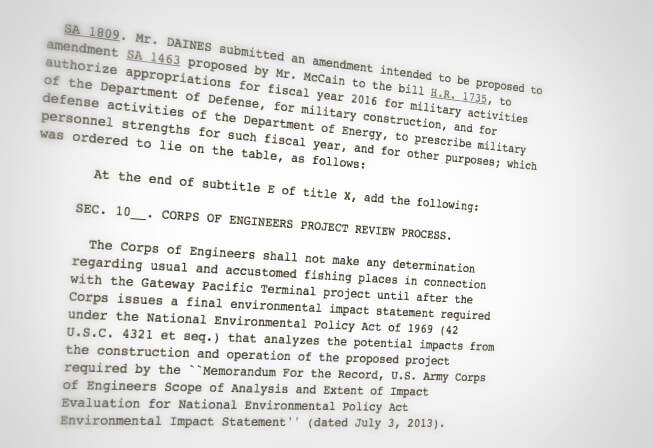
Excerpt of Senate Amendment (S.A.) 1809, proposed by Senator Daines on June 8, 2015
One of those amendments, Senate Amendment (S.A.) 1809, was proposed by Senator Daines on June 8. It was an amendment to Senator John McCain’s (R-AZ) Senate Amendment (SA 1463) attached to a piece of unrelated legislation, the National Defense Authorization Act (H.R. 1735) for fiscal year 2016.
Another example of Senator Daines’ attack on Lummi treaty rights was cited in LIBC Chairman Tim Ballew’s August 3 letter to the senator. His letter included a copy of the language that Daines apparently tried to insert as a proposed amendment to yet another piece of unrelated legislation (H.R. 22). The amendment text was the same language that was proposed in S.A. 1809.An excerpt from S.A. 1809 reads, “The Corps of Engineers shall not make any determination regarding usual and accustomed fishing places in connection with the Gateway Pacific Terminal project until after the Corps issues a final environmental impact statement. . .” S.A. 1809 never received debate as it was withdrawn, so it did not move forward to a vote.
Chairman Ballew admonished Senator Daines in the August 3 Lummi Nation press release:
Senator Daines has repeatedly sought to interfere in the Army Corps’ regulatory review process by seeking to attach legislative amendments to various bills moving through Congress. It’s unconscionable that, as a member of the Senate Indian Affairs Committee, he chooses to ignore treaty rights. He has repeatedly tried to diminish the rights of the Lummi Nation using “middle-of-the-night” stealth legislative tactics that have prevented stakeholders from weighing in.
BURYING AMENDMENTS IN UNRELATED LEGISLATION TO BURY TREATY RIGHTS
Amendments are often attached to unrelated bills, but riders that undermine treaties and sacred sites are particularly egregious. In December 2014, Senator McCain successfully buried an amendment he attached to the 1600-page 2015 National Defense Authorization Act (H.R. 4435). The must-pass NDAA legislation that Congress moves yearly was used as a vehicle by McCain to pass a morally suspect public lands exchange package involving land at Oak Flat, in Eastern Arizona.
Senator McCain’s “midnight” rider which disregards and diminishes treaty rights of the San Carlos Apache and other nearby tribes that he managed to sneak through in 2014, and the repeated legislative attempts by Senator Daines to trample Lummi treaty rights, illustrate the serious harm that can befall the Lummi Nation every single day that passes before the Army Corps makes its determination.
SSA Marine’s vice president Skip Sahlin, sent a May 12, 2015 letter to the Army Corps asking for an extension to respond to the Lummi Nation’s request to the Corps for an immediate denial of the GPT permit application because the terminal would interfere and impinge on the Nation’s treaty-protected fishing rights. In that letter, Sahlin claimed that allowing SSA/PIT the requested additional time “will not harm the Tribe or its treaty rights. . .”
The treaty rights of the Lummi Nation are under attack, and their Nation has had to expend untold efforts to defend those rights secured to them in 1855 by the United States. Every day that passes as the Army Corps is making its decision on the fate of the GPT permit, is another opportunity for coal-backed legislators such as Senator Daines to craft legislation aimed at weakening Lummi Nation’s treaty rights. Reasonable persons would conclude that despite Mr. Sahlin’s claim to the contrary, harm has been done to the Lummi Nation each day that has passed since February 2011, when SSA/PIT first submitted the application for its proposed GPT project to Whatcom County’s planning department.
Chairman Ballew made it clear in his letter to Senator Daines that the Lummi Nation will fight resolutely to defend and protect its treaty rights: “I can assure you, that if the Lummi Nation’s Treaty Fishing Rights are jeopardized by any efforts to allow the project to proceed, we will fight vigorously by all means necessary. In times past, our Nation and its leaders did not have the resources and were unable to stop prior efforts to construct commercial terminals in our region. That day is no more.”
From Intercontinental Cry
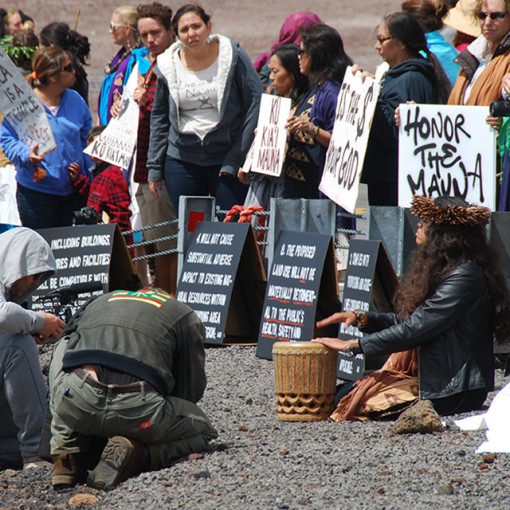
by DGR Colorado Plateau | Aug 21, 2015 | Colonialism & Conquest, Strategy & Analysis, White Supremacy
Editor’s Note: For further analysis of effective resistance movements, please visit the Deep Green Resistance Book, and read about our strategy: Decisive Ecological Warfare.
By Will Falk / Deep Green Resistance
When I am in Hawai’i, I ask everyone I meet if the United States will ever voluntarily de-occupy the Islands. No one ever says yes. Usually, before I can say anything else, people hurriedly start talking about the lack of a valid treaty or that the American occupation is illegal by their own laws or that the United States will pay for its human rights violations.
I am a haole in Hawai’i, a white settler in the United States. I acknowledge that every square inch of the United States of America exists on stolen native land. Leadership in land based struggles in the United States rests most properly in the hands of indigenous peoples. I will not undermine indigenous leadership, so I direct my thoughts to other settlers.
If no one believes that the United Sates will ever voluntarily de-occupy Hawai’i, why are so many of the movement’s settler supporters so focused on achieving this impossible voluntary withdrawal? Why, for example, do so many settlers spend so much energy supporting a parade in Oahu – a parade that is billed as a march for Hawaiian sovereignty while quietly being a voting drive to encourage participation in the occupying American government? Why do so many settlers hold up expensive court cases relying on American judges who are paid by the American government to make decisions leading to this mythical voluntary de-occupation as the only viable means for de-occupation?
The first answer is privilege. Settlers benefit from the current arrangement of power in Hawai’i. These Islands represent the tourist fantasy to many settlers despite the fact that Hawai’i’s life support systems are inches away from total collapse. The inability of settler support to recognize that Hawaiian de-occupation is our responsibility leads me to conclude that most settlers are not as concerned with Hawaiian liberation as they are concerned with maintaining a feel-good environment that balances settler crises of conscience while never threatening settler access to Hawai’i. Hawai’i does not have time to coax these settlers from their positions of privilege. So, I direct my thoughts to settlers of strong heart who simply suffer from a lack of analysis.
Apart from privilege, the second reason settlers have proven unable to mount a serious solidarity effort with the Hawaiian de-occupation movement is they see no alternative to a liberal mindset. “Wait a minute,” I hear a lot of confused readers saying, “Aren’t liberals good?” No, actually. It’s too late to rely exclusively on liberalism. Hawai’i has been cursed for 122 years of occupation with too much liberalism. Liberalism is the haoles’ game. Liberalism serves the United States of America. Liberalism renders resistance ineffective and must be forsaken if de-occupation is to be achieved.
The alternative is radicalism. An examination of the differences between the liberal and radical world views will demonstrate how radicalism arms settlers seeking to demonstrate true solidarity with a better analysis for forming an effective de-occupation strategy. This is not to say that a mixture of tactics cannot be effective. The Hawaiian de-occupation movement should not remove any tool from the table, but the longer Hawai’i remains occupied the clearer it becomes that decisive action is needed.
***
Before I begin, I would like to absolve the term “radical” of the bad reputation it has received in popular circles. Too many people confuse the word “radical” with the word “extreme.” But, as the great African-American activist Angela Davis has explained and as every major dictionary will tell you, the word radical simply means “getting to the root” and is most properly applied to political analyses that seek the origins of oppression.
The brilliant writer and activist Lierre Keith has pointed out two fundamental differences between liberals and radicals. The first difference revolves around individualism. Liberals believe that the basic social unit is the individual, while radicals believe the basic social unit is group or class. This reliance on individualism allows liberals to claim that every individual is entitled to their personal identity free from the realities accompanying social class. In fact, for many liberals, it is an insult to be identified with a certain group regardless of political reality.
For radicals, on the other hand, each individual is socially constructed by political reality. Radicals embrace their social group recognizing it as a source of strength. The first step to affecting change is making common cause with those who share your condition.
The other big difference between liberals and radicals is a disagreement on the nature of social reality. Liberals subscribe to a certain idealism while radicals root their analysis in materialism. For liberals, thoughts, mental states, and attitudes are the only sources and, therefore, solutions for oppression. Liberals locate reality in the human mind and tend to think that education is always the key to social change. For liberals, evil is a misunderstanding and if oppressors can just be shown the error of their ways, they will change.
How does this play out in Hawai’i? Take the role of white supremacism in the domination of Hawai’i, for example. Liberals, long ago, succumbed to the lie that racism and white supremacism are merely emotional states held in the hearts of individuals. They confine the definition of racism to hatred based on the color of one’s skin and confine the definition of white supremacism to hatred for everyone who is not white.
It is astronomers relying on a liberal definition of racism who can claim they are not racist because they hold no hatred in their hearts for the Hawaiian people while still insisting on destroying Mauna Kea’s summit to build telescopes. It is mining executives relying on a liberal definition of white supremacism who can claim no hatred in their hearts for native peoples while insisting that the guts be ripped from native land and poisons pumped into native waters to provide iron ore for the telescopes that destroy native peoples’ sacred sites.
Radicals see tangible systems of power maintained through force and working in the real, physical world as the sources and solutions of oppression. Education is an important first step to building radical consciousness, but they see organized political resistance and force as the means by which real change is achieved. Evil is not a misunderstanding. It is intentional and gives material benefits to oppressors. Oppression is always linked to resource extraction.
An emotional state – like hatred – might contribute to white supremacism, but radicals are less concerned with changing the hearts and minds of those murdering people of color and murdering the world, and more concerned with stopping the destruction. Hawaiian radicals, like Haunani-Kay Trask, for example, see racism as, “A historically created system of power in which one racial/ethnic group dominates another racial/ethnic group for the benefit of the dominating group.” White supremacism is the latest version of this system of power with white people dominating everyone else.
Racism and white supremacism establish, “Economic and cultural domination as well as political power…in the systemic dominance of the exploiting group.” Finally, radicals recognize, as Trask pointed out, that the dominating group holds a monopoly on the means on violence. It is this violence that must be confronted and dismantled if racism and white supremacism are ever truly going to be undermined.
To take this even further, consider what would happen if the liberal analysis was carried out to it’s logical conclusion. Imagine that liberals were actually successful at convincing those in power to treat every one in the world with love and kindness. Without a corresponding change in material reality, there would still be a huge problem. The dominant culture is built on the exploitation of natural resources. Resources are becoming scarcer and scarcer. Humans need to eat, for example, but topsoil is so depleted that major crops are all supported by oil. What will happen, despite the liberal conversion to loving kindness, when the dominant culture needs oil and indigenous peoples and others refuse to give up their lands to give them that oil?
***
A primary strength of the radical analysis is its ability to articulate the role power plays in oppression. Gene Sharp, the world’s foremost authority on civil disobedience and direct action tactics, has identified two manifestations of power – social and political. Social power, for Sharp, is “the totality of all influences and pressures which can be used and applied to groups of people, either to attempt to control the behavior of others directly or indirectly.” Political power is “the total authority, influence, pressure, and coercion which may be applied to achieve or prevent the implementation of the wishes of the power-holder.”
The powerful do everything they can to convince the oppressed that the current arrangement of power is inevitable. To believe power is inevitable is a mistake. Sharp says, “Power, in reality, is fragile, always dependent for its strength and existence upon a replenishment of its sources by the cooperation of a multitude of institutions and people – cooperation which may or may not continue.” The key to Hawaiian de-occupation, then, is dismantling American power. Power is dismantled most effectively by cutting it off at its sources.
Sharp lists six sources of power: authority, human resources, skills and knowledge, intangible factors, material resources, and sanctions. Jacques Maritain defines authority as “the right to command and direct, to be heard or obeyed by others” and Sharp notes that it is enough that those in power be perceived and accepted as superior. Human resources are simply defined as the number of people who obey those in power and will do their bidding. Those in power derive power from the skills, knowledge, and abilities of those who will do their bidding. Closely tied to skills and knowledge, intangible psychological and ideological factors like cultural history and spirituality can be leveraged by those in power to dominate others. Those in power need material resources like property, money, and sources of energy to maintain their power. Finally, those in power must have means to enforce obedience – punishment, in other words, for those who dissent.
The goal of any resistance movement aspiring to true success must engage in shrewd target selection to undermine these sources of power. Taking Sharp a step further, it is possible to prioritize which sources of power are more essential to the functioning of power than others. The most important sources of power are the material resources power depends upon and the brutality of the sanctions they can enact through their commitment to the exploitation of resources. All the other sources of power ultimately depend on the ability of those in power to enforce their power physically. This is a radical conclusion and can be easily demonstrated.
Consider the Overthrow. Did Queen Liliuokalani abdicate the throne because she believed in American authority or the inherent right of Americans to command Hawaiians? Did the Americans command more people to do their bidding in Hawai’i than the Queen? Was Queen Liliuokalani victim to some psychological failing that the Americans exploited?
The answer is obviously no. At the time, Kingdom of Hawai’i supporters outnumbered the Americans over 13 to 1 on the Islands and constituted 4/5 of the legally qualified voters in Hawai’i. Queen Liliuokalani abdicated the throne in order to avoid bloodshed and, according to her June 17, 1897 letter to President William McKinley, because she, “recognized the futility of a conflict with so formidable a power.”
Queen Liliuokalani abdicated the throne because there were 200 United States marines, holding rifles, standing outside her door. Again, it wasn’t the moral superiority of Americans that convinced the Queen. It was, quite clearly, the threat of violence. It is important to understand the physical processes that allowed the Americans to exert that kind of power in Hawai’i. Another way to understand this is to ask, How did a nation existing thousands of miles away on another continent succeed in pointing 200 rifles at Queen Liliuokalani? The answer is, superior material resources.
In order to occupy Hawai’i, Europeans had to get there first. The only way Europeans ever got to Hawai’i and then transported themselves in numbers great enough to gain power was through the use of large naval ships. In order to build these ships, those in power needed wood and lots of it. The U.S.S. Boston that provided the marines and firepower for the Overthrow was in fact one of the American navy’s first steel warships. In order to produce the steel needed to armor the U.S.S. Boston, iron ore must be harvested. To turn iron ore into steel, vast quantities of coal are needed. To mine sufficient quantities of coal, vast tracts of land housing this coal have to be ripped up. To gain access to these vast tracts of land to be ripped up, the indigenous peoples of that land have to be removed or destroyed.
It is true that the other sources of power support the exploitation of the natural world as we can see in the manufacturing of American naval ships. Coal mining, for example, requires human resources. Most humans will not voluntarily mine coal, so those in power have to employ a mixture of authority, psychological coercion, and pure violence to access the coal they need to exert more power. But, the whole system of violence requires material resources. No one is killed by authority alone. Mountain tops are not ripped off by simple knowledge. Belief systems, by themselves, do not colonize indigenous lands. Material action in the physical world produces power. Bullets, swords, or atomic bombs at various stages of human history kill people. Oil-powered excavators and dynamite blow the tops off mountains. Soldiers delivering blankets infected with small pox clear indigenous peoples off their land.
The good news is that the more destructive those in power become, the more complex their system of murder gets, the more opportunities they expose for dismantling their power. Each step in the manufacturing of the U.S.S Boston, for example, presents an opportunity for resisters to stop the replenishment of power at one of its sources. The method is simple. Restrict those in power access to the resources they require and their power weakens. Cut them completely off, and empire comes crashing down.
The physical processes that produce warships and put rifles and cannons in the hands of American troops in Hawai’i follow a similar pattern. These processes are ultimately what make civilization unsustainable. These processes demonstrate precisely how the civilized have come to dominate the world at the expense of the uncivilized and life on this planet. Again, this present state of the world is not inevitable. It is the result of power built through the exploitation of life on the planet. The problem for life right now is the American empire shows no signs of slowing. The bigger their weapons become the faster life is pushed to the brink of total extinction.
Radicalism, then – because it springs from material reality – gives the Hawaiian de-occupation movement an ecological imperative. European contact has resulted in half of Hawai’i’s endemic species being lost to extinction. How many more species must be lost before actions that truly reflect the seriousness of the situation are taken? The American empire is built on the use of fossil fuels and the American military is the single largest consumer of fossil fuels in the world. Burning fossil fuels must be stopped to avoid climate catastrophe. The American military presence is, perhaps, the most serious physical obstacle confronting the de-occupation movement. Blocking the military’s access to imported fossil fuels, then, could deal a decisive blow both to American power on the Islands and American environmental destruction.
***
This is the reality of the challenge confronting the Hawaiian de-occupation movement:The United States will never voluntarily leave Hawai’i and the survival of life on the Islands demands de-occupation. Too many settler liberals would have everyone believe that if Hawaiians just ask nicely enough, or cleverly enough, or with irrefutable American logic, the Americans will leave. Too many settler liberals hold up the American political and international legal systems as the only means for de-occupation. Too many settler liberals can be relied upon for sign-holding events, parades, and social media campaigns to achieve de-occupation, but when it comes down to being accomplices to Hawaiian liberation, we are failing.
Appealing to the American political system hasn’t worked in 122 years. Appealing to the international legal system misunderstands the material reality of power. These liberal tactics can be employed to erode American authority, to persuade humans not to support American power, but there are more decisive routes to undermining American power. It’s not that liberal tactics do not have their place. But, by themselves, they do not undermine power in any serious way.
Time is short in Hawai’i. Settlers wishing to demonstrate true solidarity need to embrace a radical analysis. It is time to get to work seriously dismantling the sources of American power.
Will Falk has been working and living with protesters on Mauna Kea who are attempting to block construction of an 18-story astronomical observatory.
Find an index of Will Falk’s “Protecting Mauna Kea” essays, plus other resources, at:
Deep Green Resistance Hawai’i: Protect Mauna Kea from the Thirty Meter Telescope
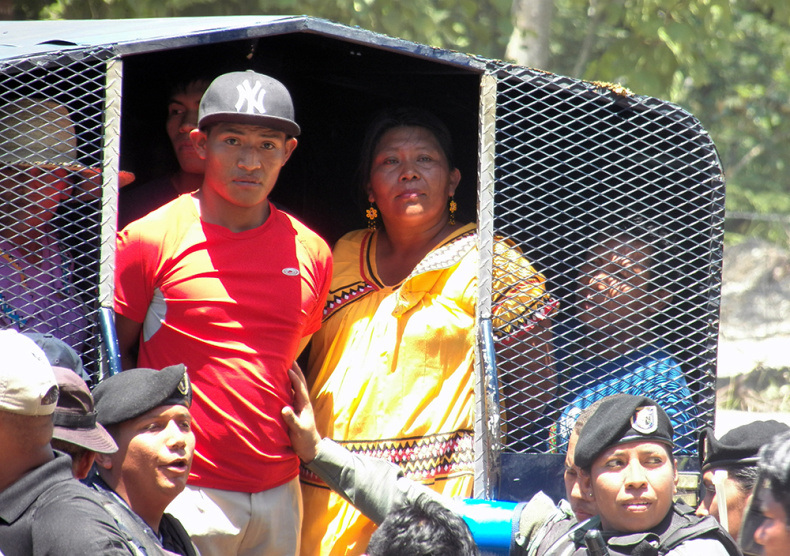
by DGR Colorado Plateau | Aug 6, 2015 | Colonialism & Conquest, Indigenous Autonomy, Obstruction & Occupation
By Richard Arghiris / Intercontinental Cry
Protests against the Barro Blanco hydro dam in western Panama turned violent last Saturday, July 25, when riot police, claiming to act in self-defense, unleashed pepper spray and batons on some 50 Ngäbe activists, women and children among them. At least three protesters were badly injured in the clash.
The crackdown occurred during a visit to the area by the Panamanian Vice President Isabel Saint Malo, who, under the pretext of dialogue, convened three Ngäbe leaders behind closed doors at the Centro Misionero (Mission Centre) in the town of Tolé. Despite a reasonable request to be included in the meeting, leaders from local community groups were excluded. Activists responded to Saint Malo’s move by blockading the Carretera Interamericana, the country’s principle highway.
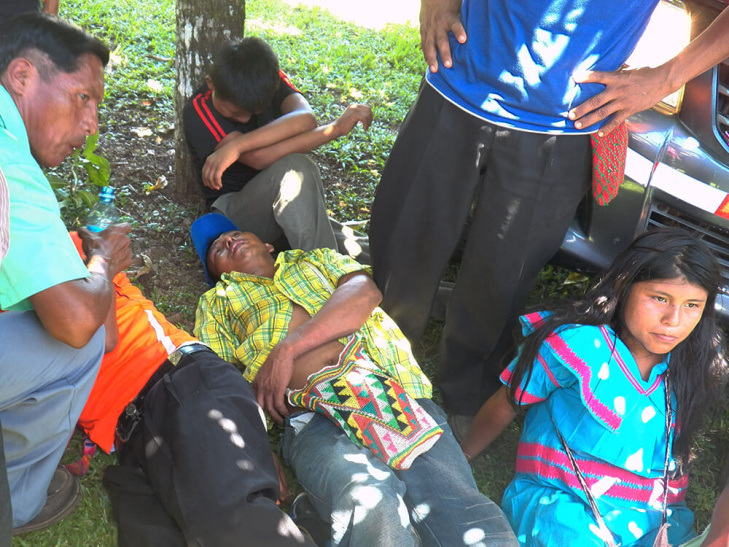
Protesters, including women and children, recover after clashes with the police. (Photo: Oscar Sogandares)
According to the Ngäbe, at around 10:15 am, in scenes reminiscent of the Martinelli years, the police reacted violently to disperse the 50-strong protesters, destroying their equipment, trashing their camps, and burning their banners.
The police deny improper use of force.

Edilma Pinto, 17, suffered a fractured foot during the police crackdown. (Photo: Oscar Sogandares)
Many fled the scene before 20 people were arrested (including several minors) and dispatched to the city of Santiago for processing.
While in the private meeting with Saint Malo, the Cacique of Muná, Chito Gallardo, and the Mayor of Muná, Rolando Carpintero, learned of the arrests and quickly intervened to have them returned. The injured were soon taken to the Casa Misionero for treatment and for the Vice President to bear witness.
According to one person at the scene, the vice president appeared coolly uninterested.
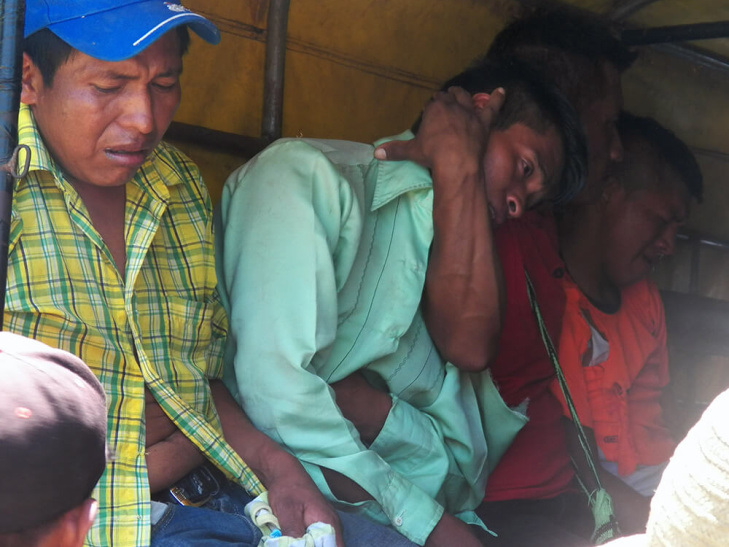
Some 20 Ngäbe protesters were detained by the police. (Photo: Oscar Sogandares)
For several weeks, hundreds of police units have been stationed in and around Tolé, including numerous SENAFRONT troops, an elite militarized squad funded in part by the United States. SENAFRONT is normally charged with defending the jungle frontier with Colombia, making their presence of considerable significance.
Under the US Leahy Law on Human Rights, the US Department of State is prohibited from providing military assistance to foreign units who violate human rights with impunity.
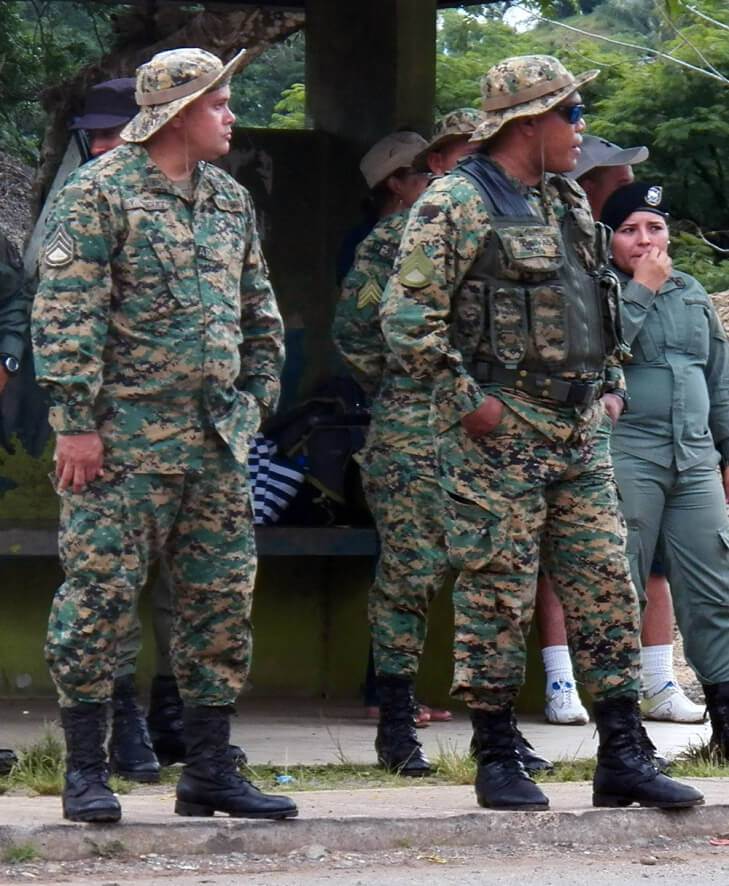
Partly funded by the US State Department, elite SENAFRONT troops have been dispatched to the area. (Photo: Oscar Sogandares)
The clashes on the Interamericana foreshadow greater unrest as Barro Blanco’s owner, Generadora del Istmo (GENISA) – a corporation owned by the controversial Kafie family, now mired in a high-level corruption scandal in Honduras – scrambles to complete the final 5-10% of the hydro dam’s construction.
The company has never sought the free, informed, and prior consent of the indigenous communities living on the banks of the Tabasará river, while the project’s funders, the Dutch and German investment banks FMO and DFE, admit to failing their own due diligence tests. Unfortunately, all funds have now been dispensed to GENISA and the banks themselves made a point of threatening the government when it suspended the project earlier this year.
The negative impacts of Barro Blanco have been identified by scores of technical teams, independent experts, international observers, and the United Nations. Those same impacts are nowhere to be found in GENISA’s Environmental Impact Assessment. Among them, the dam will displace several indigenous and campesino communities, including the community of Kiad, where a unique school and cultural centre is developing the written script of the Ngäbere language.

The ancient Ngabere language is taught at this school house in Kiad. (Photo: Richard Arghiris)
Additional impacts include the loss of farm plots and fish stocks — vital sources of sustenance for indigenous and campesino communities in the region – as well as the loss of several ancient petroglyphs, part of Panama’s national patrimony and a special significance to the Mama Tata religion, a Ngäbe revivalist movement that syncretises indigenous animism and Catholicism.
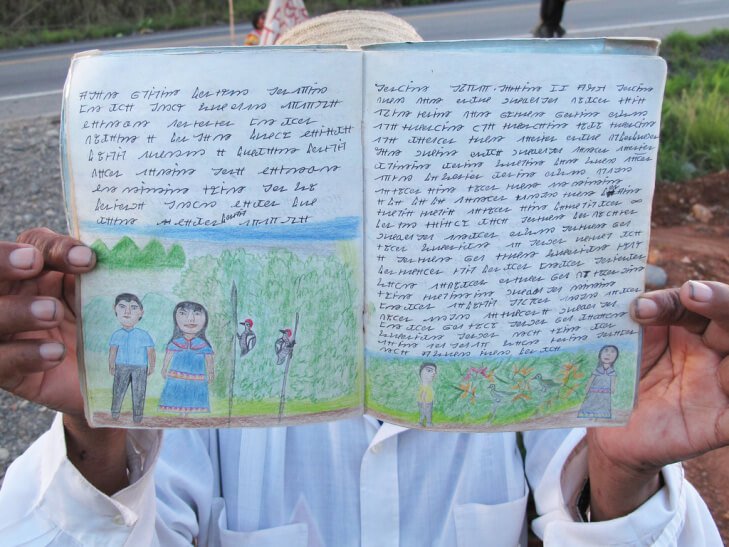
The Ngabere language is a great source of cultural pride. (Photo: Richard Arghiris)
Among the most devout followers of Mama Tata are the M22 resistance movement, who successfully blockaded the entrance to the dam for 38 consecutive days – until just ten days ago. International news footage of the groups praying and dancing on the highway may have influenced the government’s decision to enforce a ‘soft’ take-over of the site entrance. In contrast to the force deployed outside Tolé, Ngäbe women lying in the path of machinery were carefully removed.
Construction of the dam has now resumed and M22 are continuing to pray day and night by the highway. They complain of psychological intimidation with the police shining high intensity lamps on their camp during the night and aggressively entering the temple they have built near the river banks.
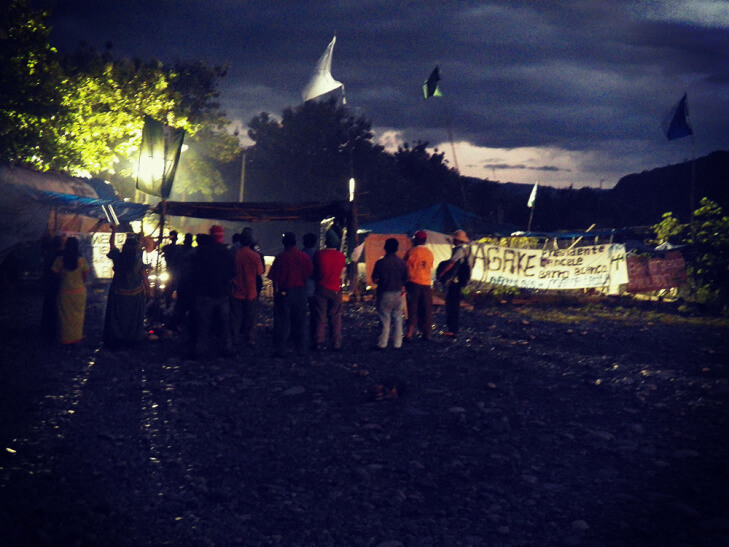
Days before their eviction from the site entrance, M22 gather for prayers under police spotlights. (Photo: Oscar Sogandares)
For his part, Panamanian President Varela, who continues to talk condescendingly about giving the Ngäbe ‘the keys to the dam’ upon its completion, appears to have acquiesced to pressures from his own business community, tacitly enabling foreign corporations who respect neither the environment nor international law nor indigenous or human rights.
The Supreme Court has cheered him on by annulling a moratorium on hydro projects passed by the environment agency, ANAM, who were concerned with the stress being placed on Panama’s delicate but biologically rich watersheds. With the crackdown last week, the Panamanian government appears officially back to business as usual.
From Intercontinental Cry: https://intercontinentalcry.org/barro-blanco-protesters-injured-and-arrested-28467/#imageclose-28472
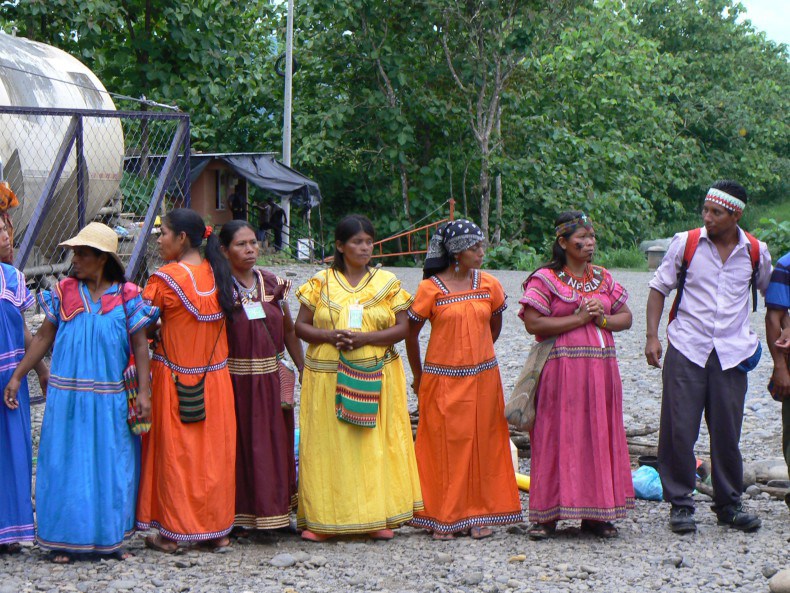
by DGR Colorado Plateau | Aug 5, 2015 | Biodiversity & Habitat Destruction, Colonialism & Conquest, Indigenous Autonomy, Obstruction & Occupation
By Richard Arghiris and Jennifer Kennedy / Intercontinental Cry
June 14, 2015
NGÄBE ISSUE ULTIMATUM TO THE GOVERNMENT OF PANAMA: CANCEL THE PROJECT BY MONDAY
A 30-strong splinter group of Ngäbe from the M10 resistance movement has blocked the entrance to the Barro Blanco hydroelectric dam in western Panama, preventing workers from entering the site. The 15 year struggle of the Tabasará river communities to protect their livelihoods, their culture, and their ancestral heritage now appears to be entering a tense new phase. With negotiations exhausted and the dam 95% complete, M10 has an issued an ultimatum for the government to cancel the project by Monday, June 15, 2015. It is unclear how the government will respond.
“Being Ngäbe-Buglé cultural patrimony,” said Clementina Pérez, part of the group camped at Barro Blanco’s gates. “Our river, our mother earth, our ecology, our existence, we are here to make known to the national and international community that this patrimony belongs to us and to the church of Mama Tata. With the conservation of peace, liberty, justice and unity, liberation and social justice… [we ask] the President of the Republic the cancellation and removal of the dam from our communities, our river and our mother earth, which belong to us as original people of the Americas…”
Funded by European banks – the German Investment Corporation (DEG) and the Dutch Development Bank (FMO) – the dam is set to inundate a string of Ngäbe and campesino communities, all of whom have voiced their objections from the outset. The flood will destroy ancestral petroglyphs, fertile agricultural grounds, and Mama Tata cultural centres, including a unique school where the emerging written script of the Ngäbere language is being developed and disseminated. The dam will significantly impact the river’s marine life, wiping out migratory fish species which many communities – both up and down stream – rely upon for essential protein. None of the Tabasará communities have provided their free, informed and prior consent to the dam, a fact recently confirmed by the FMO’s own independent complaints mechanism (ICM).
“Lenders should have sought greater clarity on whether there was consent to the project from the appropriate indigenous authorities prior to project approval,” said an ICM report, published on May 29, 2015. “[The plan] contains no provision on land acquisition and resettlement and nothing on biodiversity and natural resources management. Neither does it contain any reference to issues related to cultural heritage…”
The report is the latest in a series of professional analyses that pour a thick layer of scorn over the dam project’s owner, Generadora del Istmo (GENISA). Demonstrably unlawful, GENISA has been condemned by numerous independent investigators, the United Nations, several international NGOs, and Panama’s own environmental agency, ANAM, who found a raft of flaws and short-comings in their environmental impact assessment.
But despite failing their own due diligence, the banks appear to have shrugged off the ICM report with an insipid call for “constructive dialogue” and “a solution for a way forward.” In February this year, the FMO chose to threaten the government of Panama after building work was temporarily suspended on the recommendation of ANAM. Writing to the Vice President, the FMO warned that the suspension “May weigh upon future investment decisions, and harm the flow of long-term investments into Panama.”
The government seems to have taken this threat to heart. Panama’s president, Juan Carlos Varela, who was elected to office in 2014, flip-flopped on Barro Blanco before finally falling in line. Last week, while proffering flimsy reassurances about having found a human rights solution, his government left the negotiating table and signaled an end to the suspension of works. M10 claims the work never stopped and has been continuing clandestinely. They are now mobilizing for action.

Clementina Perez (Photo: Oscar Sogandares)
“If this situation is not resolved,” said Clementina Pérez, “We will go to the Panamerican highway to ask together, at a national level, the cancellation of Barro Blanco…”
Rising with stark grey walls above the denuded banks of the Tabasará, Barro Blanco has become a symbol of the previous administration, its fundamental violence and contempt for the rule of law. The former President Ricardo Martinelli – now on the run in the United States and facing a corruption probe back home – provoked no less than four major uprisings as he grasped for land and resources in Panama’s indigenous territories. Heavy-handed repression resulted in the deaths of several protesters and bystanders, including an unarmed teenage boy who was shot in the face by police. Barro Blanco is the visible legacy of a proudly thuggish President who serially abused Panama’s Indigenous Peoples and plundered the country at will. Thus far, Varela has been keen to strike a more decent and humane tone. How he now handles the crisis evolving on the banks of the Tabasará River will be a demonstration of his sincerity, or lack of.
From Intercontinental Cry: https://intercontinentalcry.org/ngabe-block-entry-to-barro-blanco-hydro-dam-panama-28186/
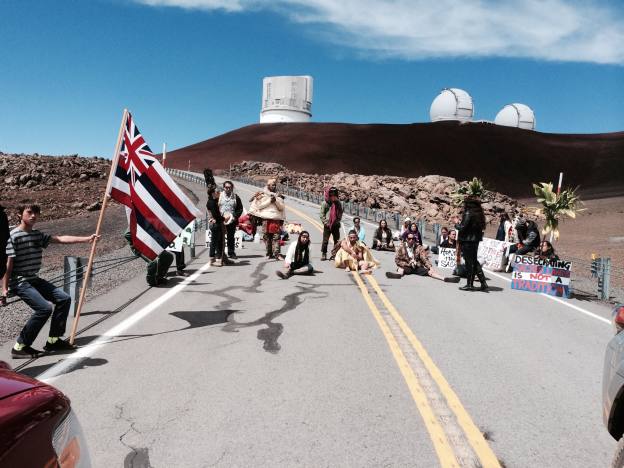
by DGR Colorado Plateau | Jul 30, 2015 | Colonialism & Conquest, Mining & Drilling
By Will Falk / Deep Green Resistance
Many view the debate surrounding the Thirty Meter Telescope’s proposed construction on Mauna Kea and Kanaka Maolis’ opposition to it as fundamentally a question of science versus culture. On the benign end, the word “science” has come to connote something close to cool and objective rationality – nothing more nor less than a collection of knowledge to be used in man’s (isn’t it always “man’s”?) noble aim to transcend nature. More malevolently, however, pitting science against indigenous culture is nothing more than insidious racism. This racism operates on the often unchallenged claim that science is an inherently western way of knowing and therefore superior to indigenous ways of knowing.
In fact, some Mauna Kea protectors wish to avoid this rhetorical ploy so strongly they can be heard saying, “We’re not against science, we’re just against building this telescope on Mauna Kea.” Their words imply that the telescope could be built somewhere else and western science allowed to run its course everywhere but here.
Personally, I am against the construction of telescopes anywhere and I have lots of problems with western science. I am careful to emphasize the adjective “western” in western science because Kanaka Maolis often remind me that they’ve always known many of the things western science claims to have discovered. Remember, as Mauna Kea protector Hualalai Keohula has reminded me, that Kanaka Maoli navigated the world’s largest and greatest ocean in canoes built with wood and stone, aided with nothing more powerful than the naked human eye, centuries before the West realized the world was round. This, it should be said, is the right way, the least destructive way, the non-violent way to practice astronomy.
I speak only for myself, here, but I will go so far to say I wish western science never existed. I know in today’s dominant culture my wish is pure blasphemy. As my friend Derrick Jensen noted in his brilliant work Dreams, science is the new monotheism. The old monotheisms – Christianity, Judaism, Islam – succeeded in removing meaning from the natural world and placed meaning in the hands of a jealous, abstract God dwelling in far-off heavens. Science, then, erased God and obliterated any possibility of meaning with Him. When I make these arguments, I’ve found it to be like Jensen has observed, when you blaspheme God, you are called a disbeliever. When you blaspheme science, you are called an idiot.
Still, on the whole, science has been a disaster for life on Earth. The first problem with science is the first problem with so many products of the murderous culture we live in. The first problem with science is science’s epistemology is rooted in this culture’s epistemology. And, this culture’s epistemology is based on domination. Epistemology is the study of how we know what we know.
One way to understand science is to trace what the leading scientific epistemologists have to say. Remember Sir Francis Bacon from your 6th grade science class? He invented what we call today “The Scientific Method.” He said his “only earthly wish is to stretch the deplorably narrow limits of man’s dominion over the universe” by “putting her (nature) on the rack and extracting her secrets.” As if that wasn’t scary enough, Bacon went on to say, “I am come in very truth leading you to Nature with all her children to bind her to your service and make her your slave.”
Or what about the hugely popular science apologist, Richard Dawkins? He writes in his book A Devil’s Chaplain: Reflections on Hope, Lies, Science, and Love that “Science boosts its claim to truth by its spectacular ability to make matter and energy jump through hoops on command, and to predict what will happen and when.”
“To make matter and energy jump through hoops on command” is a soft way to spell domination. Substitute yourself for “matter and energy” (that is what you are, of course). How would you feel if a scientist pointed a gun at you, or shot electrical currents through your muscles, or stuffed you into a cage, starved you, pumped your body full of chemicals and forced you to jump through hoops at his command?
The culture we live in is based on domination. How else do we account for the fact that one in five women will be raped in her lifetime? One in four girls and one in six boys sexually abused before they turn 18? How else do we account for the fact that 2.6 people are killed by American police every day?
Why, then, would we expect western science – a product of this culture – to be any different?
***
There’s a better way to judge science. It is a question that should form all of our moralities. The question is simple.”Is the real world better off because of science?” I think the answer to that question is a resounding no.
I come to that conclusion because my morality takes the needs of the real, physical world as primary. Water, soil, air, climate, my body, your body, and the food that sustains us are all formed by complex relationships of living beings. These living beings form the communities that make life possible. The needs of these communities must inform every action humans take. Anything else is suicidal.
I understand that science can be useful. Western science gives us modern medicine, for example, but modern medicine is more often than not a leaky band-aid applied to a wound created by science in the first place. Many tell me that western science is going to give us the cure to cancer while they forget that most cancers are produced by environmental toxins that exist because of science. I understand that western science can help us predict the devastating consequences of climate change, but science opened the road to the technologies responsible for climate change in the first place. Western science is responsible for napalm, agent orange, and atomic weapons. Of course, the surest way to prevent the destruction those weapons caused would have been to never open the doors of knowledge that lead to them.
The TMT project serves as a perfect reflection of the insanity of western science. Just like western science gains knowledge through domination, the TMT project is only possible through the domination of Kanaka Maoli. If the original people of Hawai’i were not exterminated by genocidal processes, were not made second-class citizens on their own islands, their culture not beaten to within inches of its life by American denationalization programs, Mauna Kea would be truly protected with the highest reverence.
But, western scientists have arrived, confident in the role Francis Bacon has laid out for them, to stretch Hawai’i on the rack and extract her secrets from her. The cops have come twice, with guns on their hips, to make Mauna Kea protectors vacate the Mauna Kea Access Road like Dawkins’ scientists who make matter and energy jump through hoops on command and arresting anyone who refuses the command.
Again, let’s ask the most important question of all. Is the real world better off with or without the TMT?
One way to answer this is to examine the physical processes needed to construct the TMT. Included in these physical processes are the actual materials used in construction. I am no expert on telescope construction and I’ve found it difficult so far to find detailed lists of the materials that will form the TMT (probably because acquiring these materials are a disaster for the environment.) From what I can tell, though, the TMT will be built with materials like steel, aluminum, and other rare earth metals.
You cannot have the TMT without steel, aluminum, and other rare earth metals. You cannot have steel, aluminum, and other rare earth metals without mountain top removal, open pit mining, and the combustion of vast quantities of fossil fuels. You cannot have mountain top removal, open pit mining, and the combustion of vast quantities of fossil fuels without climate change, mass extinctions, the forced removal of indigenous peoples, and the violent labor conditions present in extraction industries. So, before the materials needed to build the TMT ever even arrive in Hawai’i, they will be covered in the blood of humans and non-humans alike.
Telescopes are a disaster for the real world just like western science has been. Telescopes cannot be anything other than disasters for the real world because they are products of a murderous system of knowledge. It might be really super cool to discover the 832nd star in the 412th known galaxy with a new, massive telescope. This knowledge, however, comes through the domination of life on earth.
Mauna Kea – and I would argue all mountains – might be best understood as a complex community of living creatures living in mutual relationship. The needs of this community trump the desires of science. Mauna Kea itself acts as a giant water filter and houses the largest freshwater aquifer on Hawai’i Island. Everyone needs clean drinking water, but there have already been seven documented mercury spills associated with the telescopes on Mauna Kea. Currently threatened, endemic species call Mauna Kea home. The needs of mamane trees and ahinahina to live trumps the curiosity of astronomers to peep at other worlds.
***
Before I finish, let me anticipate the objections I will receive. Yes, I am quite aware of the comforts brought to some of us by western science. But, when we talk about how great science is for “us,” who are we talking about? Are we talking about the few indigenous societies clinging to their traditional ways of life, clinging to the only human ways of life that were ever truly sustainable? Are we talking about polar bears? Sumatran tigers? Bluefin tuna? We can’t be talking about West African black rhino because they just fell into the deepest dark of total extinction.
I know that science produced the internet, the laptop I’m typing on, and brought the delicious cold brew coffee I’m drinking. People often criticize me asking, “How can you condemn these wonderful tools you are using? You get on planes and travel to Hawai’i, you get in cars to visit places across Turtle Island, aren’t you a” – and they gasp – “a hypocrite?”
My answer is simple. Yes, I might be a hypocrite, but I believe my friend Lierre Keith who said, “Understand: the task of an activist is not to negotiate systems of power with as much personal integrity as possible – its to dismantle those systems.” Western science is a system of power and must be dismantled if we have any chance of surviving the catastrophe facing us. Sitting Bull used American made rifles to defend his people from American cavalrymen. Ken Saro-Wiwa, the Nigerian poet who was murdered for resisting Shell Oil in his homeland, wrote in English – the language of his oppressors.
I wish with all my heart that I could live as our ancestors lived – a life free from the deepest anxiety that in a few years everything might be gone. I was raised in the Wasatch and Uinta Mountains of Utah – a place I just visited – and I wish with all my heart that I could spend my life walking in Indian paintbrush, columbine, daisies, and lupine consumed in the total wonder and beauty of life. I wish with all my heart that I could sit still in simple expression of the love I feel. But, while everyone I love is under attack, it is simply unforgivable not to do everything within my power to protect them. It is simply unforgivable not to use every tool at my disposal to defend them.
History reveals western science as an accomplice to the murder of the real world. Western science is attempting the murder of Mauna Kea. Mauna Kea and the real world demand that we stop it.
Will Falk has been working and living with protesters on Mauna Kea who are attempting to block construction of an 18-story astronomical observatory with an Extremely Large Telescope (ELT).
Find an index of Will Falk’s “Protecting Mauna Kea” essays, plus other resources, at:
Deep Green Resistance Hawai’i: Protect Mauna Kea from the Thirty Meter Telescope
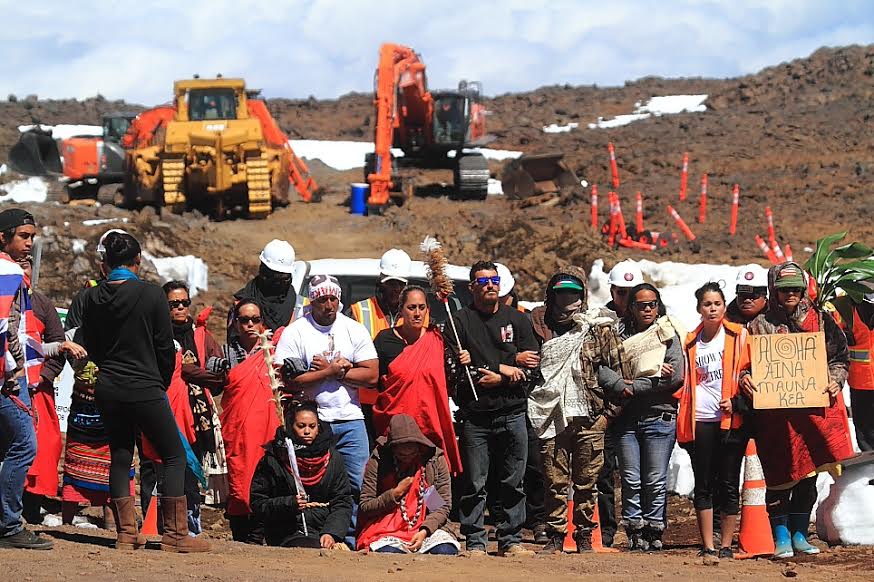
by DGR Colorado Plateau | Jul 9, 2015 | Colonialism & Conquest
By Will Falk / Deep Green Resistance
Sitting outside the 10 by 20 foot makeshift tent that has served as my home for the last 34 days on Mauna Kea, I watch the tent poles shudder to the concussion of US Army howitzer cannons firing live shells at their training grounds below. When the wind blows just right, from the south, the rattle of automatic rifle fire reaches the occupation. There’s no denying it: A war rages in Hawai’i.
It’s a war on native peoples, a war on women, a war on the land, a war on life itself. The war did not start in Hawai’i. The war began thousands of years ago with the dawn of civilization when some humans chose to live in population densities high enough that they overshot the carrying capacity of their homelands and turned to dominating other peoples in other lands. Imperialism was born, and one-by-one land-based, truly sustainable human societies were either eradicated or forced into assimilation.
The war swept west across Turtle Island (so-called North America) – where it is still being fought -leaving whole peoples destroyed and now largely forgotten. The war is carving peaks from mountains, drying rivers so they no longer flow to their ocean homes, and boiling the planet’s temperature to levels dangerously close to being unbearable for all but a few lifeforms. The war decimates the numbers of our animal kin, too. Buffalo walk the ledge above total extinction. So do salmon. So do timber wolves. So do grizzly bear.
The war in Hawai’i began in the late 1770s when Captain Cook first appeared. By 1897, a million Hawaiians were killed in battle, by introduced diseases, and through Christian missionary efforts. Half of Hawai’i’s endemic species have been exterminated since European contact. The minds of Hawaiian children were attacked when the illegal Republic of Hawai’i outlawed the Hawaiian language in Hawaiian schools in 1896. The bodies of these Hawaiian children were attacked when they were beaten for speaking their native tongue.
A genocidal program of desecration was initiated as well. Hale O Pa’pa and the Kanaka burials there were paved over by highways while Kahoolawe was bombed to hell by the American military – and that’s just to name a very few of the sites desecrated. Now, the TMT project wants to dynamite an eight acre patch of Mauna Kea’s hallowed summit to clear the way for their telescope.
***
Rumors are swirling that the TMT (Thirty Meter Telescope) project is poised to break its self-imposed moratorium on construction and send its equipment up the mountain with an armed escort. We have heard that Gov. David Ige is willing to send the national guard against the Mauna Kea protectors.
In the midst of these rumors, it is not uncommon to hear people say they hope the situation on Mauna Kea will not turn violent. The problem with expressing this hope is the situation on Mauna Kea is violent, has been violent for a long time, and will remain violent so long as those in power remain in control of the land.
Before you object to this, consider the bombs and rifle fire I am listening to as I write this.
Consider that the first time construction equipment tried to force a way over the objections of the Hawaiian people, it came with men carrying batons and pistols. These men carrying batons and pistols put 31 peaceful protectors in handcuffs, carried them to the Hilo jail, extracted 250 dollars from each one of them, and now force them to appear at a series of of court dates under threat of jail time.
Consider that David Ige, as I wrote earlier, has stated that he is willing to call in the national guard to clear the way for the TMT. Speaking of war, the national guard is an organization of soldiers. They will come with rifles instead of the police’s pistols.
This is violence.
I didn’t even mention the violence already done to Mauna Kea to build and maintain the 13 telescopes that already exist on the summit. These 13 telescopes required their own dynamite and 38 feet have been cut from the height of Mauna Kea’s summit already. There have been 7 reported mercury spills on the mountain that contains Hawai’i Island’s largest freshwater aquifer.
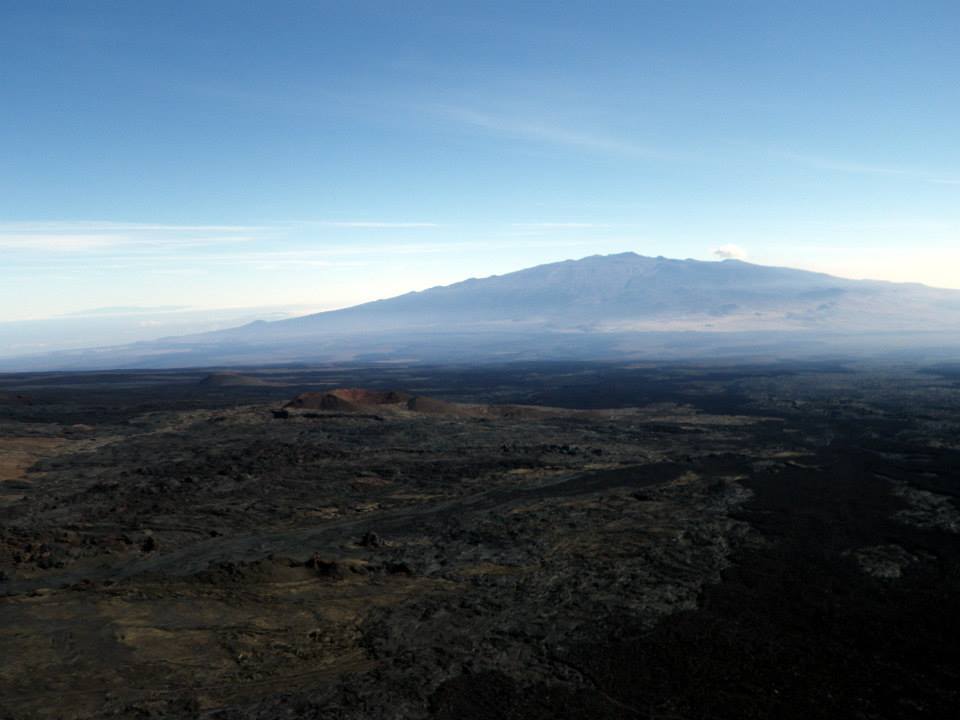
Mauna Kea
Plants, animals, and insects that live on Mauna Kea are murdered by this mercury and its more than likely that humans – especially children and the elderly – are harmed by this mercury, too.
Kanaka Maoli are genealogically related to Mauna Kea – it is literally a family member – so to do this kind of violence to the Mauna is to attack an older sibling.
Again, this is violence.
I anticipate that some may accuse me of encouraging an atmosphere of violence by using words like war to describe the violent reality facing Mauna Kea, facing Kanaka Maoli, and facing the long, necessary road to Hawaiian independence. Describing reality, however, is not the same thing as encouraging violence. I want this violence to stop and the first step to a cure is the proper diagnosis.
As a haole, I understand that when push comes to shove the State will crack down much harder on people of color than they will white people, and I do not want to provoke this crack down. I do think, though, that we need to be prepared to react when the State does not treat the protectors with the kapu aloha that the protectors will show those who come to destroy Mauna Kea.
Those who deny we are at war are wrong. Maybe, they cannot recognize the war because war has become so utterly pervasive. The wars of the past led to the rape of women. The war we’re fighting now causes one in six women to be raped in her lifetime worldwide. The wars of the past were fought to beat armies, to eradicate cultures, and to topple nations. The war we’re fighting now causes the extinction of whole species – 200 species a day, in fact, day after day after day.
Maybe, they cannot recognize the war because they are privileged enough not to confront the reality of this war. I think Palestinians understand this war. I think Catholics in Northern Ireland understand this war. I think Afghanis and Iraqis understand this war. I think hammerhead sharks, California condors, mamane trees, and ahinahina understand this war. They have to, because their survival depends on it.
Maybe, those who deny the war is happening think they can avoid the war’s dangers by ignoring it. It might be possible to avoid bullets, gas, and bombs by agreeing and cooperating with the cops as they place you in handcuffs, but you are just as susceptible to the environmental toxins the dominant culture unleashes on us every day. Denial saves no one from cancer.
Yes, Hawai’i with the rest of the world, is at war. This war – more than any other – is a war that we absolutely must win. If we lose, we lose life on this planet. To win a war, you must destroy your enemy’s ability to make war. The battle on Mauna Kea against the TMT is a mini-war in the larger war on life. The surest way to win this war is to undermine the TMT’s ability to build their telescope.
There are many strategies currently being employed to win this war – to undermine the TMT’s ability to build their telescope – but the weakness of most of these strategies is that they rely on our enemies to do the right thing. The countless sign-waving events conducted in support of Mauna Kea are designed to persuade the public of the justness of our movement. The incessant social media campaign we are waging is geared towards changing the hearts and minds of the world. The court cases challenging the TMT project, for example, rely on a judge to agree with the arguments made by our lawyers.
And why do we appeal to the courts to protect Mauna Kea? The answer is simple. If the judge rules in our favor, the decision will be backed with the full force of the State. The judge’s ruling and it’s enforcement will be backed with an organized group of men carrying guns – the police, or another organized group of men carrying bigger guns – the national guard. If we were to win in court and the TMT tried to build it’s telescope, it would be them and not us for once, who would be staring down the barrels of rifles. Of course, we do not trust the courts to do the right thing.
That’s why we stand on the Mauna Kea Access Road at this occupation.
Another way to say all this is: the State can, will, and already has used violence against us and our relations in the natural world. We must understand this in order to be effective. We must understand that writing really clever essays might not stop them. We must understand that hugging cops when they come to arrest us might not stop them. We must understand that we may not have an opportunity to place leis around the necks of national guardsmen when they point their guns at us.
I hear many people within the movement state confidently, “We will stop the TMT project.” But, if we do not understand the violence the State is capable of I feel like what we are really saying is “We will stop the TMT project as long as the police or the national guard agree to what we think are the rules.” I am not writing these things to cause despair. Rather, I am writing these things to encourage the deepest levels of commitment to protecting Mauna Kea.
Of course, those who think I am calling for violence demonstrate their own belief that only violence will stop the destruction of Mauna Kea, the destruction of Hawai’i, and the destruction of what is left of the world. I do not claim to know what will stop the destruction of Mauna Kea, but I do know that we must understand the way the State frames our tactics for us before we even begin. Once we understand this, we must ask tough questions.
I’ll walk my talk and begin: If the police or national guard overwhelms the protectors on the Mauna Kea Access Road, what do we do next?

From San Diego Free Press: http://sandiegofreepress.org/2015/06/protecting-mauna-kea-this-is-a-war/
Find an index of Will Falk’s “Protecting Mauna Kea” essays, plus other resources, at:
Deep Green Resistance Hawai’i: Protect Mauna Kea from the Thirty Meter Telescope
















